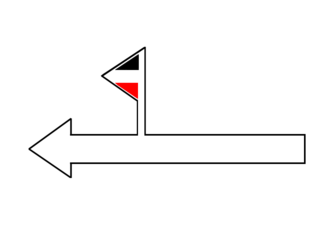
The 5th Panzer Division was an armoured division of the German Army during World War II, established in 1938.
The 1st Panzer Army was a German tank army that was a large armoured formation of the Wehrmacht during World War II.
The 11th Panzer Division was an armoured division in the German Army during World War II, established in 1940.
The XXXIX Panzer Corps was a German panzer corps which saw action on the Western and Eastern Fronts during World War II.

The 46th Infantry Division was an infantry division of the German Army during World War II that fought on the Eastern Front. Towards the end of the war, it became the 46th Volksgrenadier Division.

The 1st Cossack Cavalry Division was a Russian Cossack division of the German Army that served during World War II. It was created on the Eastern Front mostly with Don Cossacks already serving in the Wehrmacht, those who escaped from the advancing Red Army and Soviet POWs. In 1944, the division was transferred to the Waffen SS, becoming part of the XV SS Cossack Cavalry Corps, established in February 1945. At the end of the war, the unit ceased to exist.

The 23rd Panzer Division was an armoured division in the German Army during World War II. Formed in France in late 1941, the division spent its entire combat history on the Eastern Front.
Army Group F was a strategic command formation of the Wehrmacht during the Second World War. The commander of Army Group F served also as the Oberbefehlshaber Südost.

Otto Deßloch was a German Luftwaffe general during World War II and recipient of the Knight's Cross of the Iron Cross with Oak Leaves of Nazi Germany.

Desiderius Hampel was a SS-Brigadeführer und Generalmajor der Waffen-SS during World War II who commanded the 13th Waffen Mountain Division of the SS Handschar and was possibly awarded the Knight's Cross of the Iron Cross (Ritterkreuz), the highest award in the military and paramilitary forces of Nazi Germany during World War II. After the war the Yugoslavian government asked for his extradition to charge him with war crimes, but he managed to escape from a British internment camp.
The 101st Jäger Division was a light infantry Division of the German Army in World War II. It was formed in July 1942 by the redesignation of the 101st (Light) Infantry Division, which was itself formed in December 1940. The Walloon Legion was briefly attached to this division from December 1941 to January 1942. The Division took part in the Battle of Kharkov, the Battle of the Caucasus, and the retreat into the Kuban, where it suffered heavy losses fighting both the Red Army and partisans. The division was then involved in the battles in the Kuban bridgehead before being evacuated. The 101st was subsequently transferred to the lower Dnieper River in late 1943. It was part of the 1st Panzer Army that was surrounded in March 1944; it formed the rear guard for the XLVI Panzer Corps during the breakout of the Kamenets-Podolsky pocket. The division then retreated across Ukraine. In October 1944, it was moved to Slovakia and took part in the Battle of the Dukla Pass.

104th Jäger Division was an infantry division of the Germany Army in World War II. It was formed in April 1943, by the redesignation of the 704th Infantry Division, which was itself formed in April 1941. The division served in German-occupied Yugoslavia in May 1941 where it took part in anti-partisan and security operations in the Independent State of Croatia. In April 1943, it was reorganized and redesignated the 104th Jäger Division and took part in the Battle of the Sutjeska in June 1943. Following the Italian surrender, elements from the division took part in the murder of thousands of Italians from the 33 Infantry Division Acqui in September 1943, on the Greek island of Cefalonia in one of the largest-scale German atrocities to be committed by German Army troops instead of the Waffen SS.
The 129th Infantry Division was an Infantry Division of the German Army during World War II.

The 24th Infantry Division was a German Army infantry division active in World War II. It served across the Eastern Front in engagements such as the Sieges of Sevastopol and the Leningrad, finally being destroyed in the Courland Pocket in 1945.

The 41st Infantry Division, formerly the 41st Fortress Division, was a German Army infantry division in World War II. It was employed on occupation duties in southern Greece, and surrendered to the Yugoslav partisans at the end of the war.

The 297th Infantry Division was an Infantry Division within the German Army, active during the Second World War. It was one of the components of the 6th Army during its failed attack on Stalingrad.
The XV Mountain Corps was a German military formation that commanded German forces conducting counter-insurgency operations against the Yugoslav Partisans in the Independent State of Croatia during World War II.
The 361st Infantry Division was an infantry division of the German Army during the Second World War, active from 1943 to 1945. It was redesignated as a Volksgrenadier division in 1944. It saw active service on the Eastern Front when the Soviets launched Operation Bagration, during which it suffered significant losses. It later fought in France before being absorbed by the 559th Volksgrenadier Division on 10 March 1945.
The XXIX Army Corps was an infantry corps of the German Army during World War II, active from 1940 to 1945.
The LIX Army Corps, initially known as the Higher Command for Special Deployment LIX was an army corps of the German Wehrmacht during World War II. The formation was active between 1940 and 1945.









